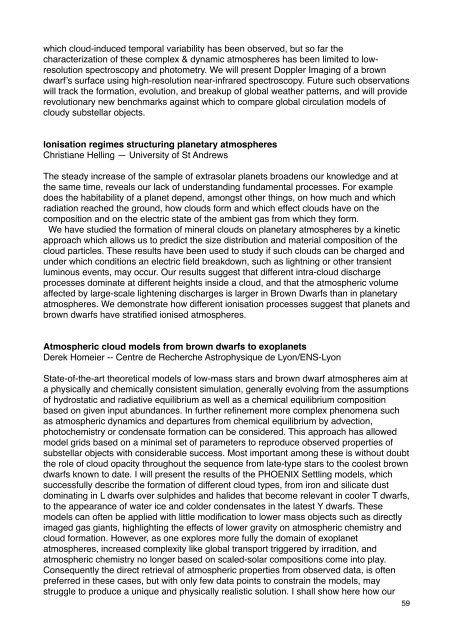Exoclimes_Conference_booklet1
Exoclimes_Conference_booklet1
Exoclimes_Conference_booklet1
You also want an ePaper? Increase the reach of your titles
YUMPU automatically turns print PDFs into web optimized ePapers that Google loves.
which cloud-induced temporal variability has been observed, but so far the<br />
characterization of these complex & dynamic atmospheres has been limited to lowresolution<br />
spectroscopy and photometry. We will present Doppler Imaging of a brown<br />
dwarf’s surface using high-resolution near-infrared spectroscopy. Future such observations<br />
will track the formation, evolution, and breakup of global weather patterns, and will provide<br />
revolutionary new benchmarks against which to compare global circulation models of<br />
cloudy substellar objects.<br />
Ionisation regimes structuring planetary atmospheres!<br />
Christiane Helling — University of St Andrews!<br />
The steady increase of the sample of extrasolar planets broadens our knowledge and at<br />
the same time, reveals our lack of understanding fundamental processes. For example<br />
does the habitability of a planet depend, amongst other things, on how much and which<br />
radiation reached the ground, how clouds form and which effect clouds have on the<br />
composition and on the electric state of the ambient gas from which they form.<br />
We have studied the formation of mineral clouds on planetary atmospheres by a kinetic<br />
approach which allows us to predict the size distribution and material composition of the<br />
cloud particles. These results have been used to study if such clouds can be charged and<br />
under which conditions an electric field breakdown, such as lightning or other transient<br />
luminous events, may occur. Our results suggest that different intra-cloud discharge<br />
processes dominate at different heights inside a cloud, and that the atmospheric volume<br />
affected by large-scale lightening discharges is larger in Brown Dwarfs than in planetary<br />
atmospheres. We demonstrate how different ionisation processes suggest that planets and<br />
brown dwarfs have stratified ionised atmospheres.<br />
Atmospheric cloud models from brown dwarfs to exoplanets<br />
Derek Homeier -- Centre de Recherche Astrophysique de Lyon/ENS-Lyon!<br />
State-of-the-art theoretical models of low-mass stars and brown dwarf atmospheres aim at<br />
a physically and chemically consistent simulation, generally evolving from the assumptions<br />
of hydrostatic and radiative equilibrium as well as a chemical equilibrium composition<br />
based on given input abundances. In further refinement more complex phenomena such<br />
as atmospheric dynamics and departures from chemical equilibrium by advection,<br />
photochemistry or condensate formation can be considered. This approach has allowed<br />
model grids based on a minimal set of parameters to reproduce observed properties of<br />
substellar objects with considerable success. Most important among these is without doubt<br />
the role of cloud opacity throughout the sequence from late-type stars to the coolest brown<br />
dwarfs known to date. I will present the results of the PHOENIX Settling models, which<br />
successfully describe the formation of different cloud types, from iron and silicate dust<br />
dominating in L dwarfs over sulphides and halides that become relevant in cooler T dwarfs,<br />
to the appearance of water ice and colder condensates in the latest Y dwarfs. These<br />
models can often be applied with little modification to lower mass objects such as directly<br />
imaged gas giants, highlighting the effects of lower gravity on atmospheric chemistry and<br />
cloud formation. However, as one explores more fully the domain of exoplanet<br />
atmospheres, increased complexity like global transport triggered by irradition, and<br />
atmospheric chemistry no longer based on scaled-solar compositions come into play.<br />
Consequently the direct retrieval of atmospheric properties from observed data, is often<br />
preferred in these cases, but with only few data points to constrain the models, may<br />
struggle to produce a unique and physically realistic solution. I shall show here how our<br />
59


